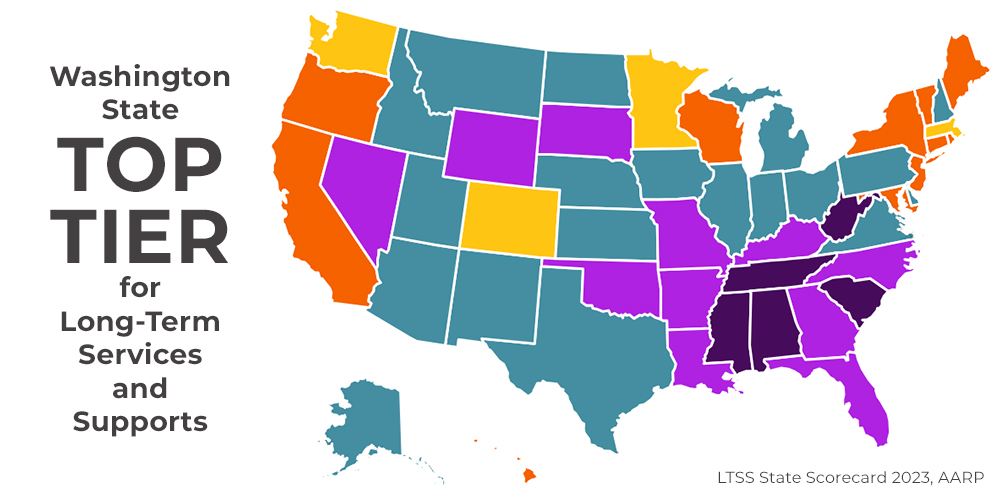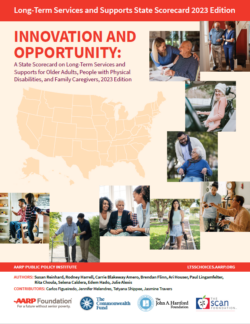Washington: #2 in the Nation for Long-Term Care Services and Supports

Washington state ranks #2 in the nation for services that help older adults age in place, according to the latest Long-Term Services and Supports (LTSS) Scorecard report from AARP. While Washington remains a national leader, major gaps persist, even here, especially related to our need for more qualified workers to help deliver home care, a too-high turnover rate for nursing home staff, and a lack of adult day services to offer respite to family caregivers.
 “Washington’s Department of Social and Health Services is committed to providing innovative services and programs, which provide quality care and allows people to remain at home or in community-based settings of their choice,” says Bea Rector, Assistant Secretary for DSHS’ Aging and Long-Term Support Administration. “We are pleased to be recognized as a leader in long-term care, and it shows the hard work and dedication of DSHS staff, providers, caregivers, policymakers, and advocates across the state.”
“Washington’s Department of Social and Health Services is committed to providing innovative services and programs, which provide quality care and allows people to remain at home or in community-based settings of their choice,” says Bea Rector, Assistant Secretary for DSHS’ Aging and Long-Term Support Administration. “We are pleased to be recognized as a leader in long-term care, and it shows the hard work and dedication of DSHS staff, providers, caregivers, policymakers, and advocates across the state.”
Washington outperformed most states and has made progress in improving care options for older adults, including the amount of Medicaid spending that goes toward home- and community-based services and a robust network of organizations at the state and community levels that help consumers and family caregivers learn about, consider and navigate LTSS options. However, the report shows there is still more to be done to keep up with the rapidly changing needs of an aging population.
“The pandemic reinforced the need to strengthen long-term care for countless loved ones across the country, including in Washington,” said Cathy MacCaul, AARP Washington Advocacy Director. “While Washington has made a decades-long commitment to bring services into the home, where older adults prefer to be, there are many roads to travel before we meet the needs of all Washingtonians who deserve the very best care, including the 820,000 family caregivers in our state. It’s time to accelerate our efforts for the sake of saving more lives.”
As the population continues aging, millions of Americans will face greater health needs over the next several decades. The country is falling short of addressing those needs, especially in how we care for people of color and those with lower incomes.
Additional key findings from the report include:
- Family Caregiving—Dozens of states experienced declines in the number of care choices that help support families managing caregiving. For instance, 21 states experienced declines of 10 percent or more in adult day services since 2016, including Washington, which ranked number 48. We also had a significant decline in access to home health aides since 2019.
- Home and Community-Based Services—there has been a surge in older adults receiving long-term care at home, rather than in nursing homes and other institutions. For the first time, more than half (53 percent) of Medicaid LTSS spending for older people and adults with physical disabilities went to Home and Community-Based Services (HCBS). Washington state leads by more than 20 percentage points, coming in at 76 percent. HCBS includes support for home health care aides, respite services, assistive technology and home modifications and other services.
- Nursing Homes and Institutional Care—A major workforce crisis exists in nursing home care. Across all states, wages for direct care workers are lower than wages for comparable occupations. In Washington, wages are $2.48 lower than other entry-level jobs. Nationally, more than half of nursing staff in nursing homes leave their job within a year (53.9 percent turnover rate). In Washington, the rate is above the average, at 54.9 Staffing disparities are a significant challenge. Residents of nursing homes with high admissions of Black residents receive almost 200 fewer hours of care per year compared to residents of nursing homes with high admissions of white residents.
“COVID-19 tested our long-term care systems, and they failed. Now is the time to take the lessons we’ve learned to fix them, for the sake of saving lives,” said Susan Reinhard, Senior Vice President, AARP Public Policy Institute. “AARP’s LTSS Scorecard shows some progress and innovation, but there’s still a long way to go before we have systems that allow people to age well and independently for as long as possible and support the nation’s 48 million family caregivers. It’s also clear some emerging issues deserve more attention—from whether nursing homes are prepared to confront natural disasters to whether they have plans in place to maintain and grow their workforces.”
 Contributor Christina Clem is a Communications Analyst at AARP Washington. For information about AARP issues and events in Washington state, click here.
Contributor Christina Clem is a Communications Analyst at AARP Washington. For information about AARP issues and events in Washington state, click here.
This article appeared in the November 2023 issue of AgeWise King County.
![Aging & Disability Services for Seattle & King County [logo]](https://www.agingkingcounty.org/wp-content/themes/sads/images/seattle-ads-logo.png)